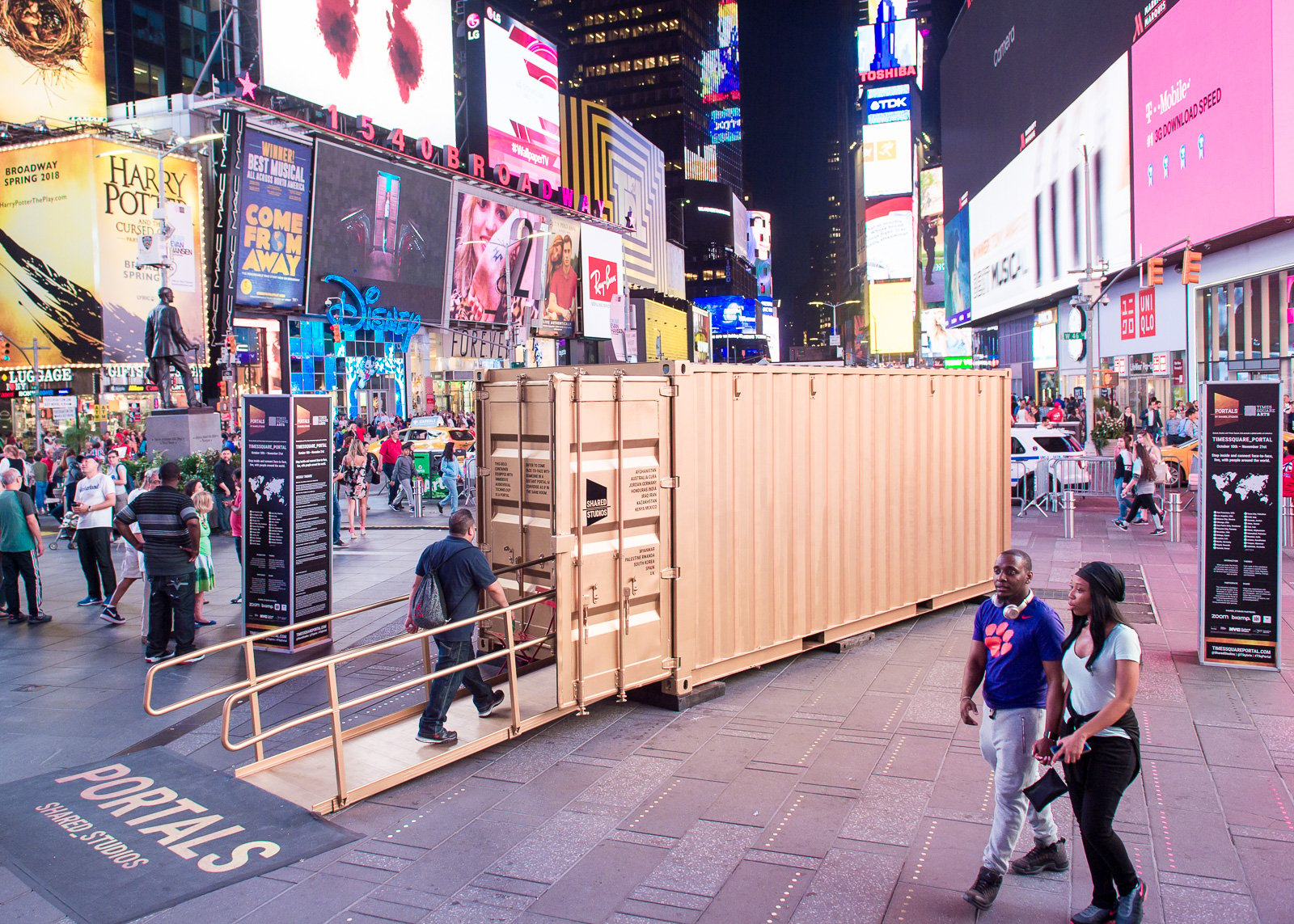
Times Square is affectionately known as the “crossroads of the world.” Now, one artist is trying to make New York’s legendary city square live up to its tagline.
Thanks to a golden shipping container that sits on Broadway, visitors can now connect instantly to far-off corners of the world, striking up conversations with strangers in such distant locations as Rwanda, Palestine, and Myanmar. The project, called the TimesSquare Portal, is run by Shared Studios, which has outfitted the container with live video capabilities to facilitate communication between people in shipping containers elsewhere. It’s part of a larger art project called Portals, which includes 24 such containers around the world.
Conceived by Amar Bakshi, the project hopes to rewire our preconceived notions about other cultures. When thinking about a large group of people, “It’s easy to sort of vilify them,” the artist told artnet News at the exhibition opening. In contrast, having a one-on-one conversation allows people to find common ground, focusing on their similarities rather than their differences.
Inside the TimesSquare_Portal. Courtesy of Ian Douglas for Times Square Arts.
Amid the rise of the smartphone and video technology, it has become easier than ever to stay in touch with far-flung loved ones. Bakshi believes that it is just as important to engage with strangers, as a way of learning more about humanity.
With its history of immigration and multiculturalism, New York is a natural fit for Portals. “From the day the Dutch arrived, New York City has been home to people from all over the world,” said New York State Assemblyman Richard Gottfried at the project’s unveiling, calling for the installation to be made permanent.
The TimesSquare_Portal. Courtesy of Ian Douglas for Times Square Arts.
Portals launched in December 2014, connecting galleries in New York and Iraq. Now, at any given time, you can step inside the container in Times Square and talk to a stranger in one of the 24 containers across the US and the world. Curators from the various sites schedule the connections, often with programming, such as dance performances or dialogues about political issues such as police-community relations in the US, or the Catalan independence referendum. They’re even recording a Portals album, featuring musicians from 20 countries.
“It’s a global public space,” explained Bakshi. “We’ve built a community of people who believe in this idea of showcasing their own diversity, and learning from and engaging the diversity of others.”
Inside the TimeSquare_Portal. Courtesy of Ian Douglas for Times Square Arts.
Portals has its headquarters in Brooklyn, but its first permanent site, established in March 2015, is in Herat, Afghanistan. Curator Omid Habibi heard about the project on BBC Persia, so he reached out to Bakshi, and had a portal up and running within just a few weeks. The project grew quickly from there.
“I was so under-educated before I got a portal,” Lewis Lee, a Portals curator in Milwaukee, told artnet News. “It helped me to kill a lot of stereotypes.” Lee’s portal is in the city’s crime-ridden Amani neighborhood, in the 53206 zip code, which has the nation’s highest incarceration rates for African-American men. He claims there has been a 21 percent reduction in crime since the portal was installed a year and a half ago. (artnet News has reached out to Milwaukee authorities to confirm the reduction rate but had not heard back as of press time.)
Visitors inside the TimesSquare_Portal. image courtesy of Ian Douglas for Times Square Arts.
In New York, visitors can reserve a time slot or go during walk-in hours. There is also a series of performances and other events.
Like many artworks, the project has taken on new weight in the age of Trump. “The benefits of globalization have extended to relatively few people,” Bakshi said. He hopes Portals can help offer a different kind of advantage to isolated communities.
Visitors at the TimesSquare_Portal. Image courtesy of Ian Douglas for Times Square Arts.
“The benefits that come from engaging people who are not like yourself are massive. It changes the way you view the world, and it increases the avenues you have to realize whatever dreams or goals you might have,” he added. “The world is a beautiful place if we embrace its diversity, rather than fear it.”
TimesSquare_Portal is on view at Broadway Plaza between West 46th and 47th Streets, October 10–November 21, 2017.